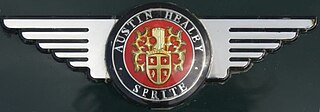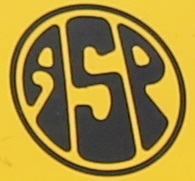
The Lotus Seven is a small, simple, lightweight, two-seater, open-top, open-wheel, sports car produced by the British manufacturer Lotus Cars between 1957 and 1972.

A kit car is an automobile available as a set of parts that a manufacturer sells and the buyer then assembles into a functioning car. Usually, many of the major mechanical systems such as the engine and transmission are sourced from donor vehicles or purchased new from other vendors. Kits vary in completeness, consisting of as little as a book of plans, or as much as a complete set with all components to assemble into a fully operational vehicle such as those from Caterham.

The Lotus Elite name has been used for two production vehicles and one concept vehicle developed and manufactured by British automobile manufacturer Lotus Cars. The first generation Elite Type 14 was produced from 1957 until 1963 and the second generation model from 1974 until 1982. The Elite name was also applied to a concept vehicle unveiled in 2010.
Caterham Cars is a British manufacturer of specialist lightweight sports cars established in Caterham, Surrey, with their headquarters in Crawley, Sussex. Their current model, the Caterham 7, originally launched in 1973, is a direct evolution of the Series 3 Lotus Seven designed by Colin Chapman. In the 1990s the company made the Caterham 21, a two-seater soft top alternative to the MGF and Lotus Elise,. A track-only car, the SP/300.R, a joint project with Lola was released for customer testing in 2010 and was scheduled for release in 2013. On 27 April 2011, Team Lotus owner Tony Fernandes announced that he had purchased Caterham. On 2 April 2021, news was leaked that Caterham Cars was acquired outright on 31 March 2021 by VT Holdings, Japanese importer for the Caterham Seven since 2009. As well as being a Caterham importer, VT also imports Lotus cars and Royal Enfield motorcycles into Japan.

The Austin-Healey Sprite is a small open sports car produced in the United Kingdom from 1958 until 1971. The Sprite was announced to the press in Monte Carlo by the British Motor Corporation on 20 May 1958, two days after that year's Monaco Grand Prix. It was intended to be a low-cost model that "a chap could keep in his bike shed", yet be the successor to the sporting versions of the pre-war Austin Seven. The Sprite was designed by the Donald Healey Motor Company, with production being undertaken at the MG factory at Abingdon. It first went on sale at a price of £669, using a tuned version of the Austin A-Series engine and as many other components from existing cars as possible to keep costs down.
Westfield Sportscars were manufacturers of both factory built and kit versions of several two-seater, open top sportscars. Their main product was a Lotus Seven inspired car – vehicles originally designed by Colin Chapman with only the bare essentials for motoring in order to give the rawest and most exhilarating driving experience.

The Caterham 7 is a super-lightweight sports car produced by Caterham Cars in the United Kingdom. It is based on the Lotus Seven, a lightweight sports car sold in kit and factory-built form by Lotus Cars, from 1957 to 1972.

Lotus Elan is the name of two separate ranges of automobiles produced by Lotus Cars. The first series of cars was produced between 1962 and 1975 as a rear-wheel drive vehicle. The second series was produced between 1989 and 1995 as a front-wheel drive vehicle.

Ashley were manufacturers of body shells and chassis for specials from 1955 to 1962. They also offered a range of products for special builds: radiators, header tanks, lighting sets, steel tubing, sheet aluminium, various suspension parts, water pumps, tires, tubes and wheels. The company also made bonnets and hardtops for other mass-produced sports cars, including the Austin-Healey Sprite and Jaguar E-Type.

Alpha Street productions and later Alpha Sports Productions (ASP) were an Australian kit car and racing car manufacturer. It has made sports cars and open wheeler cars. Originally building cars based on the Lotus Seven but have evolved to construct their own distinctive designs.

The SEiGHT is a sports car manufactured as a kit or factory built vehicle by Westfield Sportscars. It is based on the familiar Lotus Seven concept, created by Colin Chapman, whose design philosophy was to strip a car design down to bare essentials for the ultimate in driving experiences. Bar a few visual differences, such as a bonnet bulge to house the large engine, it uses the same widebody chassis as the smaller engined SEi. All SEiGHTs are defined as such by the powerplant - a V8 engine. In kit form they are only available from the factory as a rolling chassis, unlike other Westfield kits which can be bought in component form.

Robin Hood Engineering Ltd was a British kit car manufacturer based in Mansfield Woodhouse, Nottinghamshire. The factory covered 30,000 square feet (2,800 m2) and was on a one and a half acre site.

The MG Midget is a small two-seater sports car produced by MG from 1961 to 1979. It revived a name that had been used on earlier models such as the MG M-type, MG D-type, MG J-type and MG T-type.

Elva was a sports and racing car manufacturing company based in Bexhill, then Hastings and Rye, East Sussex, United Kingdom. The company was founded in 1955 by Frank G. Nichols. The name comes from the French phrase elle va.

GTM Cars were a component kit car manufacturer located in Kingswinford, UK.

The Lotus Eleven is a sports racing car built in various versions by Lotus from 1956 until 1958. The later versions built in 1958 are sometimes referred to as Lotus 13, although this was not an official designation. In total, about 270 Elevens of all versions were built.
Sylva Autokits is a kit car manufacturer based in Lincolnshire, England. Sylva was founded in 1981 by Jeremy Phillips and has developed and produced a number of small and lightweight sports cars. Sylva cars have won a number of 750 Motor Club Kit Car championships.
The Blakely Bantam was a kit car produced by Blakely Auto Works, a manufacturer of kit cars located in a series of US midwest communities in the 1970s and 1980s. Blakely Auto was founded by Dick Blakely to market affordable sports cars in the spirit of the legendary Lotus Seven: compact, lightweight, and with excellent handling. The Bantam's design inspiration was the Dutton, a Lotus Seven replica built in Britain. The Bantam was introduced in 1972 as Blakely's first offering, followed by the larger Bearcat and eventually by the Bernardi. Production of the Bantam continued into the 1980s, when the model was renamed the Hawk, and stopped with the dissolution of Bernardi Auto Works in the later 1980s.
Marlin is a British sports car manufacturer founded in 1979 in Plymouth as Marlin Engineering and now located in Crediton, Devon, England.

New Zealand had a long history of small garages and vehicle enthusiasts modifying and creating sports and sports racing cars. Out of these interests grew the New Zealand kit and replica car industry with the introduction of fibre-glass car bodies in the 1950s.















